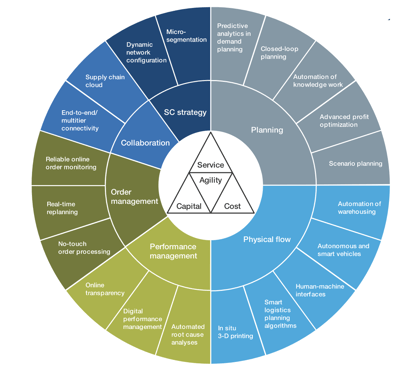In January 2018, Business Insider found that 42 percent of organizations surveyed identified supply chain and operations as driving revenue from AI capabilities today. Early adopters are dominating the space and seeing huge gains, while those still leveraging traditional analytics are falling further behind.

This year has been touted as the year that AI actually comes to fruition (or some variation thereof) by multiple publications - here’s just one example. So why all the buzz around the supply chain, given that it’s already historically been one of the more data-driven industries or sectors out there? Is there really that much to gain?
In a word, yes. And here’s why:
- There are multiple applications: We’re not talking about just one small part of the whole that machine learning (ML) and AI have the opportunity to affect - in fact, there is opportunity throughout the chain, from more efficient delivery routes to price optimization and everything in between.
- The data is so siloed today: Across the supply chain, data is stored in many different places with different systems, and it’s rare to consider it all together as a whole. That’s why when enterprises do break down information silos there is so much to uncover that was previously unseen.
- The opportunity for automation is huge: When it comes to ML and AI in the supply chain, it isn’t just about optimization, but also automation - removing steps from the process that humans previously had to do manually.
Getting There
The classic example of real-time supply chain automation and (probably) AI that works is Zara. And other companies - in retail and beyond - are beginning to follow suit, “microsegmenting” demand for hyper-optimization.

Supply chain 4.0 - source: McKinsey
But AI isn’t magic - the challenges that lie ahead are often simply getting started, breaking down the silos between data and systems to pave the way for AI optimization. But there are a few key steps to starting the journey that are critical. Namely, evangelizing the importance of being a data-powered enterprise throughout the entire company, not just among the core data team. This means more data transparency, but in a smart way, which calls for:
- Providing easy access to data combined from all sources to build projects encompassing data from anywhere.
- The ability to both design data solutions and deploy those solutions in production for real-time insights.
- The ability to automate workflows associated with these insights.
- Careful monitoring of ML models in production to prevent drift and ensure they are working as intended.
So getting started is the hardest part. But it’s not just organizational logistics, though everything above can certainly be a challenge. It’s also getting staff to understand how data can be used differently in supply chain to move toward AI (and, perhaps even more importantly, why it’s important).
The International Institute for Analytics (IIA) recently released a report exploring the link between analytics capability and company performance (spoiler alert: there is one, and it’s positive). So for further proof that advance analytics, and particularly AI, are worth investing in even for already traditionally data-driven sectors, check out the report.




